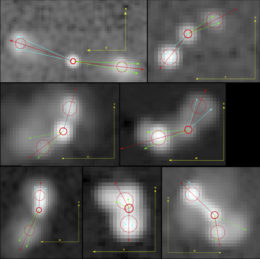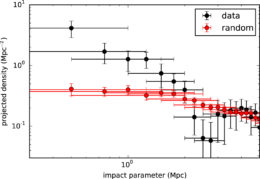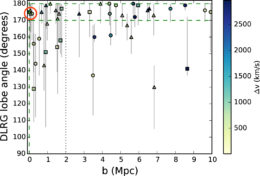Powerful jets emitted from the centers of distant galaxies make for spectacular signposts in the radio sky. Can observations of these jets reveal information about the environments that surround them?
Signposts in the Sky

VLA FIRST images of seven bent double-lobed radio galaxies from the authors’ sample. [Adapted from Silverstein et al. 2018]
These distinctive double-lobed radio galaxies (DLRGs) don’t all look the same. In particular, though the jets are emitted from the black hole’s two poles, the lobes of DLRGs don’t always extend perfectly in opposite directions; often, the jets become bent on larger scales, appearing to us to subtend angles of less than 180 degrees.
Can we use our observations of DLRG shapes and distributions to learn about their surroundings? A new study led by Ezekiel Silverstein (University of Michigan) has addressed this question by exploring DLRGs living in dense galaxy-cluster environments.

Projected density of DLRG–central galaxy matches (black) compared to a control sample of random positions–central galaxy matches (red) for different distances from a cluster center. DLRGs have a higher likelihood of being located close to a cluster center. [Silverstein et al. 2018]
Living Near the Hub
To build a sample of DLRGs in dense environments, Silverstein and collaborators started from a large catalog of DLRGs in Sloan Digital Sky Survey quasars with radio lobes visible in Very Large Array data. They then cross-matched these against three galaxy catalogs to produce a sample of 44 DLRGs that are each paired to a nearby massive galaxy, galaxy group, or galaxy cluster.
To determine if these DLRGs’ locations are unusual, the authors next constructed a control sample of random galaxies using the same selection biases as their DLRG sample.
Silverstein and collaborators found that the density of DLRGs as a function of distance from a cluster center drops off more rapidly than the density of galaxies in a typical cluster. Observed DLRGs are therefore more likely than random galaxies to be found near galaxy groups and clusters. The authors speculate that this may be a selection effect: DLRGs further from cluster centers may be less bright, preventing their detection.
Bent Under Pressure

The angle subtended by the DLRG radio lobes, plotted against the distance of the DLRG to the cluster center. Central galaxies (red circle) experience different physics and are therefore excluded from the sample. In the remaining sample, bent DLRGs appear to favor cluster centers, compared to unbent DLRGs. [Silverstein et al. 2018]
These results support the idea that ram pressure — the pressure experienced by a galaxy as it moves through the higher density environment closer to the center of a cluster — is what bends the DLRGs.
What’s next to learn? This study relies on a fairly small sample, so Silverstein and collaborators hope that future deep optical surveys will increase the completeness of cluster catalogs, enabling further testing of these outcomes and the exploration of other physics of galaxy-cluster environments.
Citation
Ezekiel M Silverstein et al 2018 AJ 155 14. doi:10.3847/1538-3881/aa9d2e


1 Comment
Pingback: bent jets from SMBHs provide clues